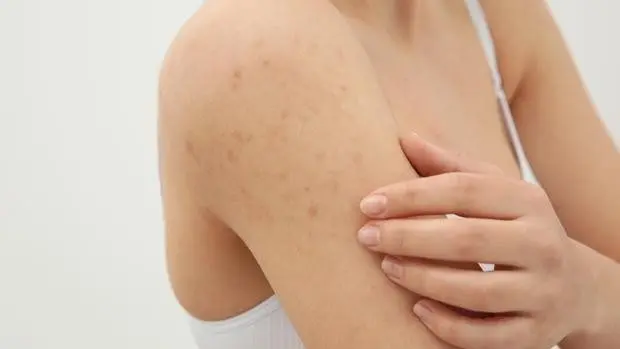Contents
How to remove annoying pimples on arms and feet that look like acne but are not
Care
Keratosis pilaris can appear without cause and requires exfoliation and hydration for its treatment

We are not talking about acne. Those ‘pimples’ that appear on the arms or legs have another name: keratosis pilaris, commonly referred to as ‘goosebumps’. “They usually appear on the back of the arms, legs, chest and buttocks,” says Estefanía Nieto, technical director of Omorovicza.
Many times people mistake this condition for an acne breakout, but its appearance is of a different nature. They comment from the Healthy Skin Foundation that this occurs in isolation, although it can be associated with “phototypes or darker skin and atopic dermatitis.” What’s more, can be associated with obesity, diabetes, renal failure, or even with the use of drugs, such as systemic corticosteroids, lithium and vemurafenib.
If it occurs, then, in isolation, it may be more common in women after giving birth and in the teenage years. Elisabeth de San Gregorio, technical director of Medik8 comments that keratosis pilaris is produced by an excess of a protein known as keratin, that is, an accumulation of dead cells on the hair follicles, giving rise to the formation of small pimples or bumps on the skin. “In some cases, when the accumulation is high, these pimples become excessively irritated causing the skin to acquire a very reddish tone,” he adds.
Consequences of ‘goosebumps’
About what problems can it generate This skin disorder, from the Foundation indicate that in general it tends to have more of an aesthetic implication, especially when it occurs in more exposed areas such as the face.
«It can also cause a some skin roughness, accompanied by dryness “, they indicate. It is very rare, but it may also cause mild itching or itching. “They usually disappear without residual injury, although sometimes they can leave a residual scar, especially those that occur in the facial region,” they warn. In addition, they add that, in general, this condition improves with the summer, and worsens in the winter, due to the lower environmental humidity.
What to do to improve it
On how we can treat it, Estefanía Nieto and Elisabeth de San Gregorio explain that two steps must be taken: that of the exfoliation to remove this accumulation of dead cells, to work on improving cell renewal; and that of deep tissue hydration. Regarding what type of products to use, the Foundation recommends emollient lotions and topical scrubs (containing lactic acid, salicylic acid or urea).
Also, it is important to note that take good skin care, and good hygiene. From the Healthy Skin Foundation they leave several recommendations, aimed at maintaining a good level of moisture in the skin.
– Avoid excessive friction when drying the skin. We can even leave it a little damp.
– Limit the shower time to no more than 10-15 minutes and use lukewarm water.
– Use moisturizing creams after bathing.










